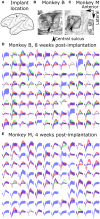An Improved Unscented Kalman Filter Based Decoder for Cortical Brain-Machine Interfaces
- PMID: 28066170
- PMCID: PMC5177654
- DOI: 10.3389/fnins.2016.00587
An Improved Unscented Kalman Filter Based Decoder for Cortical Brain-Machine Interfaces
Abstract
Brain-machine interfaces (BMIs) seek to connect brains with machines or computers directly, for application in areas such as prosthesis control. For this application, the accuracy of the decoding of movement intentions is crucial. We aim to improve accuracy by designing a better encoding model of primary motor cortical activity during hand movements and combining this with decoder engineering refinements, resulting in a new unscented Kalman filter based decoder, UKF2, which improves upon our previous unscented Kalman filter decoder, UKF1. The new encoding model includes novel acceleration magnitude, position-velocity interaction, and target-cursor-distance features (the decoder does not require target position as input, it is decoded). We add a novel probabilistic velocity threshold to better determine the user's intent to move. We combine these improvements with several other refinements suggested by others in the field. Data from two Rhesus monkeys indicate that the UKF2 generates offline reconstructions of hand movements (mean CC 0.851) significantly more accurately than the UKF1 (0.833) and the popular position-velocity Kalman filter (0.812). The encoding model of the UKF2 could predict the instantaneous firing rate of neurons (mean CC 0.210), given kinematic variables and past spiking, better than the encoding models of these two decoders (UKF1: 0.138, p-v Kalman: 0.098). In closed-loop experiments where each monkey controlled a computer cursor with each decoder in turn, the UKF2 facilitated faster task completion (mean 1.56 s vs. 2.05 s) and higher Fitts's Law bit rate (mean 0.738 bit/s vs. 0.584 bit/s) than the UKF1. These results suggest that the modeling and decoder engineering refinements of the UKF2 improve decoding performance. We believe they can be used to enhance other decoders as well.
Keywords: brain-computer interface; brain-machine interface; encoding model; neural decoding; neuroprosthetic; unscented Kalman filter.
Figures






Similar articles
-
Adaptive decoding for brain-machine interfaces through Bayesian parameter updates.Neural Comput. 2011 Dec;23(12):3162-204. doi: 10.1162/NECO_a_00207. Epub 2011 Sep 15. Neural Comput. 2011. PMID: 21919788 Free PMC article.
-
Training in Use of Brain-Machine Interface-Controlled Robotic Hand Improves Accuracy Decoding Two Types of Hand Movements.Front Neurosci. 2018 Jul 11;12:478. doi: 10.3389/fnins.2018.00478. eCollection 2018. Front Neurosci. 2018. PMID: 30050405 Free PMC article.
-
Shared Prosthetic Control Based on Multiple Movement Intent Decoders.IEEE Trans Biomed Eng. 2021 May;68(5):1547-1556. doi: 10.1109/TBME.2020.3045351. Epub 2021 Apr 21. IEEE Trans Biomed Eng. 2021. PMID: 33326374
-
Decoding methods for neural prostheses: where have we reached?Front Syst Neurosci. 2014 Jul 16;8:129. doi: 10.3389/fnsys.2014.00129. eCollection 2014. Front Syst Neurosci. 2014. PMID: 25076875 Free PMC article. Review.
-
Neural Decoders Using Reinforcement Learning in Brain Machine Interfaces: A Technical Review.Front Syst Neurosci. 2022 Aug 26;16:836778. doi: 10.3389/fnsys.2022.836778. eCollection 2022. Front Syst Neurosci. 2022. PMID: 36090185 Free PMC article. Review.
Cited by
-
Less is more: selection from a small set of options improves BCI velocity control.J Neural Eng. 2025 Mar 17;22(2):10.1088/1741-2552/adbcd9. doi: 10.1088/1741-2552/adbcd9. J Neural Eng. 2025. PMID: 40043320 Free PMC article.
-
A stack LSTM structure for decoding continuous force from local field potential signal of primary motor cortex (M1).BMC Bioinformatics. 2021 Jan 22;22(1):26. doi: 10.1186/s12859-020-03953-0. BMC Bioinformatics. 2021. PMID: 33482716 Free PMC article.
-
Rhesus monkeys learn to control a directional-key inspired brain machine interface via bio-feedback.PLoS One. 2024 Jan 17;19(1):e0286742. doi: 10.1371/journal.pone.0286742. eCollection 2024. PLoS One. 2024. PMID: 38232123 Free PMC article.
-
Selection of Essential Neural Activity Timesteps for Intracortical Brain-Computer Interface Based on Recurrent Neural Network.Sensors (Basel). 2021 Sep 24;21(19):6372. doi: 10.3390/s21196372. Sensors (Basel). 2021. PMID: 34640699 Free PMC article.
-
Unsupervised learning of stationary and switching dynamical system models from Poisson observations.J Neural Eng. 2023 Dec 12;20(6):066029. doi: 10.1088/1741-2552/ad038d. J Neural Eng. 2023. PMID: 38083862 Free PMC article.
References
LinkOut - more resources
Full Text Sources
Other Literature Sources
Miscellaneous

